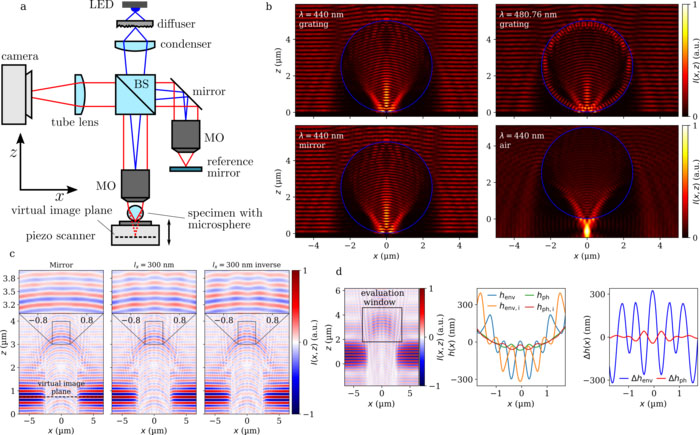| Nov 04, 2022 |
New model found for microsphere-enhanced interferometry
(Nanowerk News) Optical measurement techniques collecting light intensity in the far-field such as conventional and confocal microscopy or coherence scanning interferometry (CSI) enable fast and contactless inspection of several types of specimens. Nonetheless, optical measurement instruments suffer from diffraction effects leading to a fundamental lateral resolution limitation given by the minimum resolvable period length of Abbe-limit and the objective lens's numerical aperture (NA).
|
|
In a new paper published in Light: Applied Manufacturing ("FEM-based modeling of microsphere-enhanced interferometry"), a team of scientists led by Professor Peter Lehmann from the University of Kassel have developed a new model for modeling microscopic imaging under microsphere-enhanced interference microscopy.
|
 |
| a) Schematic representation of a high NA microsphere-assisted coherence scanning interferometer. b) Intensities of exemplary FEM simulations of the interaction between vertical incident light and the surface combined with a microcylinder for different material and wavelength setups. The different setups are used to study influences of various physical effects occurring in the interaction on CSI measurement results. c) Simulated CSI (NA=0.9) results (called interferograms) obtained from a dielectric plane mirror, a phase grating with period length 300 nm and the same grating shifted laterally by the half of the period length. As shown in the magnified area, the grating profile can be obtained in the focal plane of the sphere. d) Simulated interferogram from a grating with 300 nm period length obtained by CSI with NA=0.52. Note that according to the Abbe resolution limit in air, this grating should not be resolved. The middle figure shows grating profiles reconstructed by envelope (env) and phase (ph) evaluation for the grating and its inverse (laterally shifted by half period length). As shown, the grating is obviously resolved due to the assistance of the microcylinder. The right figure displays the difference of the grating profile and the inverse one. The standard deviation of this difference can be considered as a quantity for the resolution and is zero if the grating is not resolved. (Image: Tobias Pahl, Lucie Hüser, Sebastian Hagemeier and Peter Lehmann)
|
|
Microspheres can be applied in microscopic imaging and measurement to overcome the resolution limit. Microspheres placed close to the surface are shown to enable a local improvement of the lateral resolution and a magnification enhancement. Microspheres can be combined with CSI to obtain electromagnetic phase information. Since the improvement of optical resolution is of great interest in many fields of application of microscopic imaging, microsphere-enhanced measurements are part of many recent experimental and theoretical publications.
|
|
Microspheres of high refractive index material can be combined with immersion objectives or embedded in elastomers. Microsphere-assisted measurements also apply to biological and medical objects such as viruses and sub-cellular structures or for identifying blood cells. As a result, microsphere-assisted measurements are used in many applications. Many theoretical studies are conducted to understand and analyze phenomena leading to resolution enhancement.
|
|
The research team has presented a simulation. It considers the full imaging process of a microsphere-enhanced interference microscope working in reflection mode equipped with objective lenses of high numerical aperture using a FEM calculation of the near-field scattering process. In contrast to previous theoretical models, they considered the full 3D conical Köhler illumination with incident waves and conical imaging of the scattered light field by the microsphere.
|
|
The model reliably reproduces measurement results, as demonstrated for several surface topographies measured with CSI. A first quantitative comparison with measurement results of microsphere-assisted interferometry is given. Using the model, the researchers have presented a method to qualify the resolution enhancement by a microsphere. They have demonstrated the relative improvement of the lateral resolution and have shown that the enhanced lateral magnification decreases with for high numerical apertures. In contrast, the field of view increases for larger NA values of the objective microscope lens.
|
|
Furthermore, the presented approach enables future researchers to analyze parameter influences and finding the most appropriate experimental setup depending on the shape, size, and material of the microelement as well as surrounding material to improve the resolution and profile fidelity of CSI. The model can be extended to conventional microscopy, confocal microscopy, and other optical profilers without significant effort. Therefore, the presented model can significantly contribute to a better understanding of microsphere-assisted measurement systems and improve their imaging capabilities through parameter studies.
|

